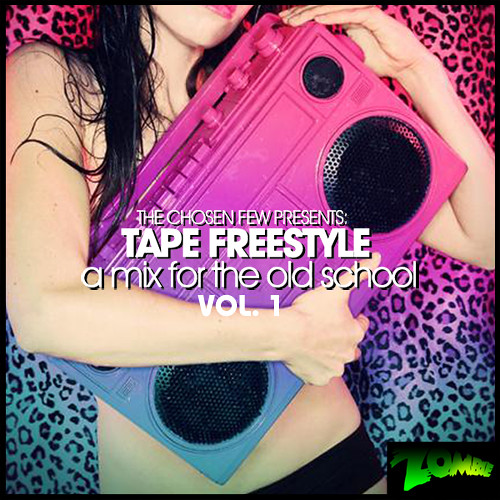The remnants of Monterrey's socialist party are holed up in Cafe Nuevo Brasil drinking Bohemias and plotting Mexico's next revolution. The jukebox blurts out another hit by Colombian diva Shakira, "Eres una canción, escrita por las manos de Dios..."
In the corner, a middle-aged revolutionary with long hair and Buddy Holly glasses peers suspiciously over his menu at an overworked bureaucrat. Two Lolitas in black spandex pants, snapping their gum in unison, lean against the jukebox. A car horn sounds and the cafe door swings open, a dry singeing heat battening down anything that comes unhinged. After approximately five days, 10 hours, and 45 minutes of interview negotiations, in walks Celso Piña, "El Rey de la Cumbia Colombiana."
An elderly gentleman with an indulgent shock of pomaded white hair springs to his feet and engulfs the music legend in a bear hug. Piña, reared in Colonia la Campana -- one of the toughest 'hoods in Monterrey, Mexico -- makes the rounds, pressing flesh, kissing cheeks, backslapping. He wants it known that despite the Latin Grammy nominations and the gold and platinum records on his wall, he hasn't forgotten la gente.
After working the room, Piña sits down and orders ice water. On the street, "the King" looks like any other working class guy in black pants and a red shirt with the top two buttons undone. Only stylized Italian sunglasses and a gold chain hint that this cumbia player has finally arrived. In 2001, when Piña's platinum single "Cumbia Sobre el Rio" was released on his Barrio Bravo CD (WEA Latina), there wasn't a car or living room from Chicago to Chiapas that didn't have the bass booming and the sonic onslaught layered with accordion rattling their windows.
With this track, Piña and producer Toy Hernández, the mix-master wizard for Monterrey's Control Machete, created a whole new hybrid by mixing the galloping rural rhythms of Colombian cumbias with the anarchy of urban streets. Imagine tuning your AM dial past Los Tigres del Norte and Shakira and coming across a cumbia from some futuristic megalopolis in Latin America: "Desde Monterrey, pura cumbia Colombiana para todo el mundo"...
El Rebelde del Acordeón
Back in the day, if you wanted to see Monterrey's king of cumbia Colombiana, you navigated the twisted hulks of burned out cars and barking dogs up the hill to Piña's modest home in Monterrey's working class Colonia la Campana neighborhood. These days, Piña's tour bus spends little time gathering dust there, as the accordion player has been touring almost nonstop in support of 2001's Barrio Bravo, and now his latest release, Mundo Colombia. After 20 years and 17 albums, Piña, at the age of 48, is an overnight success, which both amuses him and makes him enormously proud. Last summer he was nominated for two Latin Grammys, for best "Contemporary Tropical Album" and "Best New Artist From the North." He also landed a "Best Alternative Artist" nomination for the upcoming MTV Latino awards in Miami.
"Some people say my success came too late, but I've still got a lot of years ahead of me," he says, sipping his ice water. "If God wants, I'll keep on going."
In Monterrey, Piña has enjoyed local legend status since the early Eighties, even though it took Barrio Bravo to jettison him worldwide. Producer Julian "El Moco" Villareal, ex-bass player for one of Monterrey's finest bands, El Gran Silencio (who pioneered the fusion of rock and cumbia in Monterrey), suggested Piña try mixing it up with some of Mexico's younger generation of musicians.
The list grew until half of Mexico's alternative hit parade, from Cafe Tacuba to Control Machete, had been assembled. The album turned out to be a raucous, rollicking ride, but it was "Cumbia Sobre el Rio" -- a brilliant mix of cumbia, rap, reggae, and rebajada -- that had an immediate impact on all who heard it -- especially the musicians. Beno, one of the singers for Genitallica, Monterrey's answer to the Beastie Boys, says he was blown away by the tune.
"We'd all been listening to reggae, rap, and cumbia, we just hadn't thought of putting it all together," says Beno, who spent most of the summer in Austin recording Genitallica's next album. "We were like, 'This is fuckin' great!'"
"I took a chance," says Piña of his collaboration with Hernández. "We flipped a coin and it worked -- we came up with something new."
Suddenly, Piña was hip. Music writers from Argentina and Spain hiked up the hill to la Campana, looking for Graceland. After 20 years of playing his heart out in half-empty cantinas, Piña's boat had finally reached port.
Bienvenidos a Mi Barrio
Piña, it is said, almost single-handedly created the burgeoning cumbia scene in Monterrey with his first album in 1980. Since then, a number of other Monterrey groups, like Javier Lopez y Sus Reyes Ballenatos, have followed in his footsteps. A folkloric music born in Colombia's Caribbean coastal region, cumbia sabanera and its cousin cumbia vallenata were forged from a fusion of European accordion, native Indian guacharaca (a bamboo scraper), and African rhythms played on the caja, a drum slightly larger than a bongo. 
Over time, the cumbia lineup supersized, sometimes rivaling salsa bands in its musical girth, incorporating everything from horn sections to keyboards. Live, Piña keeps it simple, playing accordion and singing, while his backing band, Ronda Bogota, consists of his brothers Rube on the guacharaca and Lalo on the caja and congas, and Enrique playing the guitar or bass.
As salsa took the rest of Mexico by storm in the Sixties and Seventies, cumbia Colombiana found fertile ground in Monterrey. Just two hours from the Texas border, about seven hours from Austin, the city is one of the wealthiest in Mexico, known for its industry and hard-working populace, who keep close ties with the states.
Here the social classes are sharply divided, the rich, SUV-driving residents living in heavily policed and gated communities, while the city's working class residents -- the maids, carpenters -- live in ever-expanding shantytowns that hug the scenic mountains surrounding the city of almost seven million inhabitants.
It was in these tough, working class colonias that cumbia Colombiana took root as a way for the residents to forget their struggle and strife, hence the album title Barrio Bravo, which Piña calls homage "to all the rough neighborhoods in the world." Talk to any resident about Piña's own Colonia la Campana, and they'll tell you not even taxis venture there. One resident characterized the colonia thusly: "They'll kill you up there -- they don't mess around. Only Celso goes there, because he's the king."
Monterrey's Original Rude Boy
Piña's success has much to do with the musical prowess of producer Antonio "Toy" Hernández, who produced the hit track on Barrio Bravo: "Cumbia Sobre el Rio" and a remix for the radio single "La Cumbia de la Paz." Hernández also produced four songs on Piña's current album, Mundo Colombia, including the single "El Tren," wherein Venezuelan rapper Blanquito Man of the New York-based King Chango once again jumps into the mix as he did on "Cumbia Sobre el Rio." Hernández, 26, found fame as the DJ for Control Machete, a breakout hip-hop band from Monterrey, which went platinum in Mexico and won over critics stateside. With the success of the band, Hernández traveled the globe looking for new sounds that reflected his Mexican roots. He went to New York, but found the music more about Puerto Rico than Mexico. He hung out with Ozomatli in Los Angeles, but found their sound too schizophrenic. It was in East L.A. that he had an epiphany.
Watching the sons and daughters of Mexican immigrants crossing a bridge to work in downtown L.A., Hernández was reminded of the Puente del Papa back home, which divides the working class Colonia Independencia from downtown Monterrey. It was in Independencia that cumbia Colombiana was born in the early Sixties, transforming Monterrey into a unique haven in Mexico for a music melded by African slaves and rural Colombians.
"In Monterrey everyone was exposed to Colombian cumbia no matter what your class," says Hernández. "I realized I was proud of Monterrey, and I started to appreciate the magic of my city."
Rarely do Monterrey and "magic" come up in the same sentence. The city is known for its rampant consumerism and smoke-belching factories. Like Beck in L.A. with his tweaked suburban vision, Hernández, an archivist and musical fanatic, scratched the surface of his city's tarnished veneer and found poetry.
"The sounds of cumbia were born in Ethiopia and Jamaica," explains Hernández. "The word cumbe is Yoruban. You can feel Africa in the steadiness of the beat, just like reggae comes from Ethiopia."
After his epiphany, Hernández started digging into Colombian cumbia, turning away from the northern influences of rap and rock, and delving deeper into Latin America. He went to the flea market near Colonia Independencia and bought armloads of cumbia records. At the flea market, he checked out well-known sonideros like Gabriel Dueñez and Alfredo Murillo, DJs who sell homemade mix tapes and CDs. Devoted promoters of cumbia Colombiana since the Sixties, the sonideros, with their islands of cassettes and stereos, play the latest hits and give shout outs to their barrios, rapping over the music like Jamaican sound system crews.
Hernández's favorite sonidero, Dueñez, invented a type of music called rebajada in the mid-Sixties, slowing down cumbia tracks and emphasizing the bass and drums without distorting the lyrics like Houston hip-hop king DJ Screw did in the Nineties. It was from Dueñez and others that Hernández developed a deeper knowledge of cumbia Colombiana. At the same time, Hernández was discovering African artists like Nigerian maestro Fela Kuti and his trance-inducing rhythmic mantras.
It was this admiration for sonideros and African music that led to Hernández's "cumbia dub," which he premiered in "Cumbia Sobre el Rio." He was confident the song would be a hit. "I knew I had something," smiles Hernández.
Adrian Quesada, guitarist for Austin's Grupo Fantasma, said he first heard "Cumbia Sobre el Rio" on the radio, then downloaded the track off the Internet. "I wanted to hear it all the time," he says. Recently, the Fantasma collective, which covers musical territory from cumbia to salsa, met with Hernández about producing their next album and possibly signing to his label Sones del Mexside, which has a distribution deal in Mexico with Universal.

Hernández hopes to start a regional label with bands that reflect the cumbia dub aesthetic. Already he's encouraged Austin groups like the dub band Echobase and Grupo Fantasma to play in Monterrey. This month, Grupo Fantasma and Echobase will play Monterrey's Cafe Iguana, where no doubt they'll talk again with Hernández.
"He's like a mad scientist," says Quesada of the producer. "He's always pulling old records out and putting them on saying, 'Check this out.' He's going deeper into the history of music with hip-hop, Afro-dub, and Sly and Robbie -- reviving the careers of older musicians."
Sonidero Nacional
While Hernández and Piña are cooking up a new urban cumbia sound, the popularity of Colombian cumbia continues to grow exponentially in Monterrey. In the early Nineties, there was just one AM radio station devoted to the music. Now, there are three, with more undoubtedly planned in the future. While Monterrey has developed a love affair with Colombian cumbia, the funny thing is no musician, including Piña, has ever been to Colombia. That said, Piña and other cumbia lovers look to the country as a sort of musical Valhalla. The explanation as to how this northern industrial city became a bastion of Colombian music ranges from pure myth to possible fact.
Alfredo Zapata, a professor of cultural studies at the University of Monterrey, says the popular myth is that back in the Sixties a Colombian and his Mexican friend visited, the latter's home in Colonia Independencia. The Colombian, homesick for his country, brought several records to play at a party. The neighbors liked the music so much they made tapes, and the Colombian cumbia craze was born. While this has a lovely, simplified "big bang" theory appeal to it, the real birth of the scene was probably far more convoluted.
Zapata thinks the music was introduced over the years on age-old migratory paths, which workers would take from South America to the United States. Monterrey, long lauded as an industrial center -- where one could always find work -- attracted migrants from the south. Others on their way to the American Dream hocked records and cassettes in Monterrey so they wouldn't starve.
Meanwhile, in the working class Colonia Independencia, sonideros like Gabriel Dueñez began to play old time Colombian cumbia virtuosos like Andrés Landeros and Lisandro Meza. Gabriel Dueñez, one of Monterrey's most well-known sonideros, has been a lifelong fan of Colombian cumbia and should probably be given as much credit as Celso Piña for the music's growing popularity.
These days, the soft-spoken, 55-year-old Dueñez lives in Houston, where he repairs air conditioners in order to make enough money for his music stand back home. Coincidentally enough, Dueñez has spent several years, off and on, in Houston -- the same territory where DJ Screw created his molasses-like "screw" music with rap. A lover of many types of music, Dueñez says he has listened to Screw's music in Houston and enjoyed it.
"I think it's beautiful," he says.
A hardcore collector, Dueñez has amassed at least 2,000 records since he started collecting in 1962, some of them rare Colombian recordings that are more than 70 years old. Over the years, there have been sonidero showdowns, with Dueñez having to prove his prowess with the mic and his prodigious record collection. It was around 1965 that Duenez created the first rebajada, which he says was an accident.
"I was making a tape for a client and something broke inside my tape recorder," he says. "I mistakenly copied a slowed down version of Andrés Landeros; it changed the bass and rhythm and gave it a more distinct sound."
Toy Hernández has continually lauded the influences of sonideros like Dueñez, which are reflected in Piña's songs "Cumbia Sobre el Rio" and "El Tren," which highlight the rebajada style. (Piña was also a sonidero for several years.) In the lyrics of "Cumbia Sobre el Rio," singer Blanquito Man raps the mantra "Sonidero, sonidero nacional" over Piña's lyrics. In homage to the master of rebajada, Hernández stopped off at Dueñez's music stand at the flea market for a blessing prior to submitting Piña's tracks to the record company.
"He gave me his benediction," smiles Hernández.
When Dueñez talks about cumbia, he becomes as animated as a young kid instead of a 55-year-old grandfather. And yet, his tienda at the flea market is losing customers because no one wants cassettes any more. The kids want CDs these days, not homemade tapes. So Dueñez, retired after 22 years of busting his hump in a steel foundry, is now fixing leaky pipes and repairing AC units for gringos in Houston so he can purchase a CD burner to win back the fickle customers.
More Regio Than the Cerro de la Silla
Piña is aware that people think he's Colombian, and laughs at the common misconception. 
"I'm more regio than the Cerro de la Silla," he says referring to the term used for Monterrey's locals and its famous saddle-shaped mountain.
Someday he'll visit Colombia, but for now he's content with touring Mexico and the United States. Piña insists that neither he nor his audience has changed, and yet invitations from MTV and the Latin Grammys don't come without a price. For one, there's always another TV crew huffing and puffing up the hill in search of Piña's modest, powder-blue home.
As Piña and his influence move farther and further beyond his mountainous home state, the louder criticisms are that he's no longer true to his people. Javier Lopez, lead singer of the popular cumbia group Javier Lopez Y sus Reyes de Ballenatos, says Piña has strayed too far from his roots.
"He doesn't sound like himself anymore," claims Lopez.
In his own music, Lopez says he tries to stay true to his home, Colonia Independencia, where ingenuity always trumps poverty. The 42-year-old Lopez is proud of his barrio and the resourcefulness of its people. In one CD sleeve, Lopez shows himself and band mates scaling a hill on burros, the only transportation that the poor have to bring propane and water up the mountains to their homes.
"Once I helped a governor get elected, because he promised to bring roads and services to my neighborhood," smiles Lopez. "He won, but we are still waiting."
Repeatedly, the question is put to Lopez, Piña, and others about what makes the Monterrey version of cumbia Colombiana different from Colombian style. Everyone admits it's different, but they're hard-pressed to explain said differences.
"I think in Colombia they say we miss a lot in the feeling -- that we should stick to mariachi," says Lopez. "We do play different. I guess it's in the feeling. We're not copying them, we are making our own style."
Both Lopez and Piña stay away from the epic storytelling of the corrido and the Norteño style of groups like Los Tigres del Norte, with their ballads of immigrant lives or high-rolling narcos. Cumbias are for celebration, for forgetting your sore back and money worries.
"I don't write songs about cocaine or narcos, and I don't sing about politics," says Piña. "I don't understand politics -- I'll leave that to those who think they do."
Still, the characteristics of cumbia lyrics are changing in the hands of Mexican musicians, becoming more reflective of their struggles with poverty and the loneliness of life in the big city. In the Nineties, La Tropa Vallenata had a hit with its bittersweet song "Los Caminos de la Vida," in which a son beat down by life and broke wishes he could care for his mother in her final years.
"The struggle of the people is tremendous," says Lopez. "Most of them come from the country and are just trying to survive in a big city."
Celso Piña is one of those survivors. Tomorrow he leaves for Mexico City, where he'll play a music festival for thousands. His new CD Mundo Colombia is climbing the charts with the same eclectic style of the previous Barrio Bravo. This time out, he's recorded several outstanding tracks, especially "La Piragua" with Julieta Venegas, one of Mexico's best alternative singers. And Toy Hernández is once again behind the mixing board with his cumbia dub style.
Piña may steer clear of politics in his lyrics, but his amalgamation of styles is breaking down barriers. Piña, for his part, feels right at home. ![]()















































